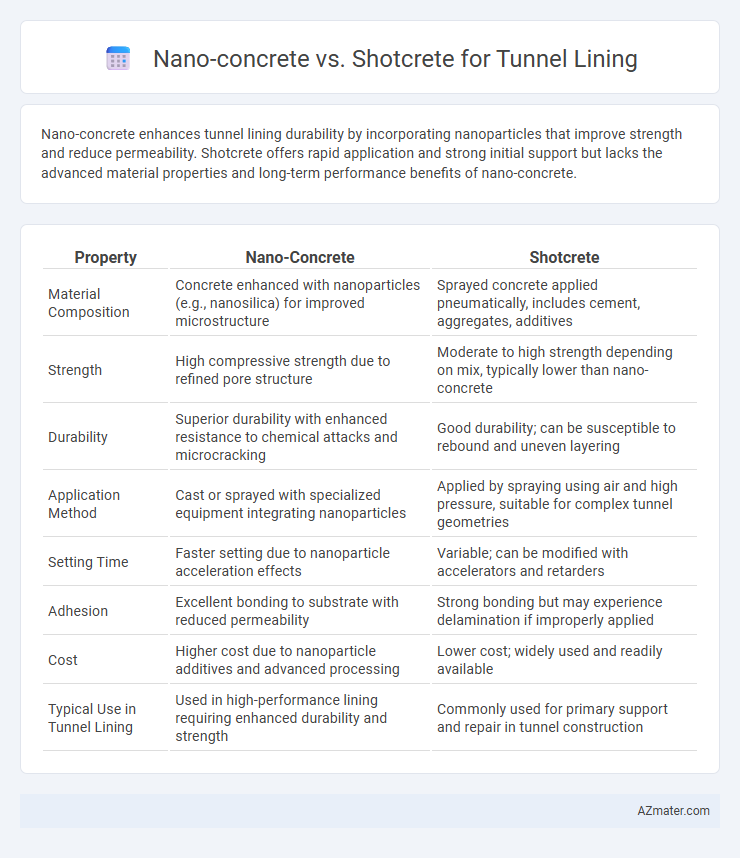Nano-concrete enhances tunnel lining durability by incorporating nanoparticles that improve strength and reduce permeability. Shotcrete offers rapid application and strong initial support but lacks the advanced material properties and long-term performance benefits of nano-concrete.
Table of Comparison
| Property | Nano-Concrete | Shotcrete |
|---|---|---|
| Material Composition | Concrete enhanced with nanoparticles (e.g., nanosilica) for improved microstructure | Sprayed concrete applied pneumatically, includes cement, aggregates, additives |
| Strength | High compressive strength due to refined pore structure | Moderate to high strength depending on mix, typically lower than nano-concrete |
| Durability | Superior durability with enhanced resistance to chemical attacks and microcracking | Good durability; can be susceptible to rebound and uneven layering |
| Application Method | Cast or sprayed with specialized equipment integrating nanoparticles | Applied by spraying using air and high pressure, suitable for complex tunnel geometries |
| Setting Time | Faster setting due to nanoparticle acceleration effects | Variable; can be modified with accelerators and retarders |
| Adhesion | Excellent bonding to substrate with reduced permeability | Strong bonding but may experience delamination if improperly applied |
| Cost | Higher cost due to nanoparticle additives and advanced processing | Lower cost; widely used and readily available |
| Typical Use in Tunnel Lining | Used in high-performance lining requiring enhanced durability and strength | Commonly used for primary support and repair in tunnel construction |
Introduction to Tunnel Lining Technologies
Tunnel lining technologies have evolved to enhance structural integrity and durability in underground construction. Nano-concrete incorporates nanoparticles to improve strength, reduce permeability, and increase durability, making it suitable for complex tunnel geometries. Shotcrete, a sprayed concrete method, offers rapid application and excellent adhesion for immediate support, widely used for tunnel stabilization and lining.
Overview of Nano-concrete
Nano-concrete enhances tunnel lining performance by incorporating nanoparticles, which significantly improve its mechanical strength, durability, and resistance to micro-cracking compared to conventional shotcrete. The nano-sized particles fill the cement matrix's voids, resulting in a denser microstructure that offers superior water resistance and faster setting times, critical for underground construction environments. Application of nano-concrete in tunnels reduces maintenance needs and increases structural longevity due to its improved bonding properties and enhanced resistance to chemical attacks.
Overview of Shotcrete
Shotcrete is a widely used tunnel lining material applied by spraying concrete at high velocity onto tunnel surfaces, providing efficient structural support and ground stabilization. Its adaptability allows for quick application in irregular tunnel profiles, making it ideal for initial support and reinforcement during excavation. Shotcrete's composition typically includes cement, aggregates, and admixtures that enhance workability and durability under underground conditions.
Material Properties: Nano-concrete vs Shotcrete
Nano-concrete exhibits superior material properties compared to traditional shotcrete, including enhanced compressive strength, reduced permeability, and improved durability due to its nano-sized particles that fill micro-pores effectively. Shotcrete provides rapid application and good adhesion but generally has higher porosity and lower tensile strength relative to nano-concrete. The incorporation of nanomaterials in concrete significantly optimizes mechanical performance and long-term resistance, making nano-concrete a preferred choice for tunnel lining in aggressive environments.
Application Techniques and Equipment
Nano-concrete employs advanced nanomaterials to enhance strength and durability, requiring precision mixing and spraying equipment to ensure uniform application in tunnel linings. Shotcrete leverages pneumatic or robotic spraying systems for rapid placement, ideal for complex tunnel geometries and immediate structural support. Both techniques demand specialized equipment, but nano-concrete application emphasizes controlled dispersion of nanoparticles, while shotcrete prioritizes high-velocity delivery for adhesion and compaction on uneven surfaces.
Durability and Longevity Comparison
Nano-concrete exhibits superior durability compared to shotcrete for tunnel lining due to its enhanced microstructure and reduced porosity, which significantly minimizes water ingress and chemical attacks. Shotcrete, while effective for rapid application and flexibility in complex geometries, tends to have higher permeability and potential for micro-cracking under stress, impacting long-term structural integrity. The advanced nanomaterials in nano-concrete contribute to increased lifespan and reduced maintenance costs, making it a preferred choice for tunnels requiring exceptional longevity and durability.
Cost Analysis and Economic Considerations
Nano-concrete offers enhanced durability and reduced maintenance costs compared to traditional shotcrete, making it a cost-effective solution for tunnel lining despite its higher initial material expense. Shotcrete provides quicker application and lower upfront costs but may incur higher long-term expenses due to more frequent repairs and lower lifespan. Economic considerations must balance immediate budget constraints with lifecycle cost savings provided by nano-concrete technology in tunnel infrastructure projects.
Environmental Impact and Sustainability
Nano-concrete enhances tunnel lining sustainability by incorporating nanoparticles that improve material durability and reduce cement consumption, thereby lowering carbon emissions compared to traditional shotcrete. Shotcrete, while convenient for rapid application, often involves higher cement usage and dust generation, contributing to increased environmental footprint. The reduced permeability and greater longevity of nano-concrete minimize maintenance needs and resource depletion, making it a more eco-friendly choice for sustainable tunnel construction.
Case Studies: Real-world Tunnel Projects
Case studies from real-world tunnel projects demonstrate that nano-concrete offers enhanced durability and superior crack resistance compared to traditional shotcrete, leading to longer service life in tunnel linings. In projects like the Gotthard Base Tunnel, nano-concrete's improved mechanical properties contributed to reduced maintenance costs and increased structural integrity under high stress. Conversely, shotcrete remains favored for its ease of application and cost-effectiveness in temporary supports, though it often requires additional reinforcement for permanent lining solutions.
Future Trends in Tunnel Lining Materials
Nano-concrete offers enhanced durability, reduced permeability, and improved mechanical properties compared to traditional shotcrete, making it a promising material for future tunnel lining applications. Advances in nanomaterials integration are expected to increase the sustainability and longevity of tunnel structures while reducing maintenance costs. Research into self-healing nano-concretes and smart monitoring systems is driving innovation toward more resilient and adaptive tunnel linings.

Infographic: Nano-concrete vs Shotcrete for Tunnel lining
 azmater.com
azmater.com